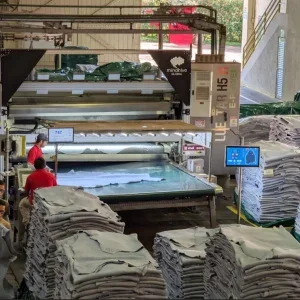LANXESS is introducing a new technology and service concept specifically geared towards the many and varied requirements of cuttingedge production processes in the beamhouse."There is great potential for innovation in this area in particular", believes Dr Matthias Hüttl, head of global product management preparation and tanning in the company’s Leather business unit.
The innovative X-Zyme process is a groundbreaking innovation that forms a central tenet of this strategy. The new, enzyme-based technology was developed in collaboration with Danish biotechnology specialists Novozymes A/S, Bagsværd, who also manufacture two pure enzymes that are essential to its functioning by means of bacterial fermentation.
"The use of two microbial enzymes in the soaking and liming noticeably improves the quality of the pelt, reduces the amount of waste and makes the entire process much more efficient", explains Dr Marc Hombeck, head of new business in LANXESS’s leather business unit.
Peltec X-Zyme S, which is used in the soak, is a Glucosidase – a carbohydratesplitting enzyme – with customised properties which include rapid opening-up and accelerated rehydration of the hide. This means that excellent soaking results can be obtained after just four to six hours. And as the enzyme has no proteolytic activity, the soaking process can be extended – even left overnight – without damaging the collagen.
In the liming process, Peltec X-Zyme U, a specific protease with high selectivity for prekeratin, is applied to remove the hair and the epidermis. This product primarily targets the basement membrane of the epidermis, thereby loosening the hair roots and preparing for the subsequent unhairing. There is no need for reductive chemicals that are required in conventional hairsaving processes and yet Peltec X-Zyme U tackles the residual hair root problem. Further advantages of the new process are a lower effluent load and reduced need for chemicals.
Production-scale trials of both the products and the process at customers’ plants have proven their efficiency and reliability. The X-Zyme process is robust and can be controlled very accurately and reproducibly by means of parameters such as the temperature and the pH of the float.
"The new process ideally meets all the main requirements with regard to productivity, product quality and environmental protection", says Hombeck.
The X-Zyme process is fully in line with LANXESS’ Sustainable Leather Management initiative. It offers a potentially higher area yield and improved quality of the pelts. Furthermore, compared with conventional processes, it reduces the need for wetting agents (surfactants) and liming chemicals such as lime, sulphur compounds and amines. This is resulting in more favourable wastewater values like sludge, COD, sulphide and nitrogen. In addition, the rapid opening-up of the hide in the soak and the reduced amount of alkali ensure high-quality pelts.
The X-Zyme process was developed specially for the Peltec product line, which in turn is geared specifically to the requirements of the beamhouse. The range includes leather chemicals for all four process stages – soaking, liming, deliming and bating.
"We are confident that integrated solutions such as our Peltec concept will provide more efficiency, sustainability and quality in the beamhouse, giving our customers competitive advantages and opening up new mutual business opportunities. This includes best-in-class products, processes, expert advice and onsite technical service – worldwide, of course", says Dr Markus Eckert, head of the LANXESS leather business unit.






